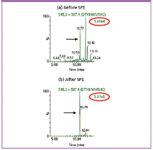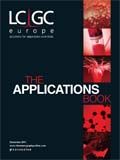Clean-up of Plasma and Serum Protein Digests for Protein Bioanalysis
Waters Application Note
Intoduction
There are various workflows for LC–MS-based protein bioanalysis. However, certain primary steps are often common to all workflows. These consist of some or all of the following: identification of unique signature peptides from the protein, isolation of the protein from a biological matrix (such as plasma), trypsin digestion of the protein or of the entire matrix containing the protein (if pre-fractionation was not performed), isolation/clean-up of signature peptides from the digest, and MRM quantitation of peptides using triple quadrupole MS.
Unless very selective enrichment of the protein is performed prior to digestion, the complexity of the digested sample, matrix effects, and the presence of isobaric interferences can make low-level quantitation difficult. The use of mixed-mode SPE to isolate signature peptides from a digest reaction can significantly improve the quality of the quantitative data. Residual denaturants, reduction, alkylation, and digest reagents will be removed during this process, as well as peptides that are more or less polar than the peptides of interest, markedly decreasing the complexity of the sample.
In this work, the monoclonal antibody, trastuzumab, a breast cancer drug, was used to demonstrate the effectiveness of an SPE clean up. Trastuzumab was spiked into serum, and the entire serum sample (without additional pre-fractionation) was denatured, reduced, alkylated and digested with trypsin overnight. Digest samples were analysed with and without additional clean up using mixedmode SPE to highlight the benefits of this important step in a protein bioanalysis workflow.
Experimental
LC–MS–MS Conditions
LC System: Waters ACQUITY UPLC System
Column: ACQUITY UPLC BEH C18 300 Å, 2.1 × 150 mm,
1.7 µm, Peptide Separation Technology
MS System: Waters Xevo TQ-S MS, ESI+
SPE Conditions
Oasis MCX µElution 96-well plate (part#186001830BA) 400—750 mL of diluted serum digest (200—375 mL digest, 200—375 mL 4% H3PO4 in water) was loaded onto the plate.
The sample wells were washed with 2% formic acid and then 5% methanol. The peptides were eluted twice with 25 µL of 40/5/55% ACN/conc. NH4OH/water (v/v/v).
Results and Conclusions
Unique trastuzumab peptides were first identified using an in silico approach. Several of the most sensitive of these peptides were chosen to represent trastuzumab in a quantitative LC–MS–MS assay. During analysis, it was noted that residual digest reagents and closely related interferences impacted LC–MS–MS sensitivity and robustness. For example, sensitivity for a system test standard decreased over time if digest samples were directly injected. In addition, many peaks were present in the MRM trace for the peptide of interest [Figure 1(a)] and the peptide signal in the presence of digested matrix was significantly lower than that of a digested solvent standard (data not shown).

Figure 1: A signature peptide DTYIHWVR detected on a Xevo TQ-S before (a) and after (b) SPE sample cleanup.
A mixed-mode SPE method was developed to clean up digest samples and to isolate the signature peptides. The SPE method not only reduced background noise, simplified the MRM spectrum and eliminated isobaric interferences, but also substantially increased signal for the signature peptide [Figure 1(b)]. SPE recovery for the signature peptide was 83%. The use of µElution format SPE enables samples to be concentrated without evaporation due to the high loading capacity and low elution volumes required.
2011 Waters Corporation. Waters: The Science of What's Possible. ACQUITY UPLC, UPLC XEVO and Oasis are trademarks of Waters Corporation
Waters Corporation
©34 Maple Street, Milford, Massachusettes 01757, USA
tel: +1 (508) 478-2000 fax +1 (508) 478-1990
Website: http://www.waters.com

Separating Impurities from Oligonucleotides Using Supercritical Fluid Chromatography
February 21st 2025Supercritical fluid chromatography (SFC) has been optimized for the analysis of 5-, 10-, 15-, and 18-mer oligonucleotides (ONs) and evaluated for its effectiveness in separating impurities from ONs.











